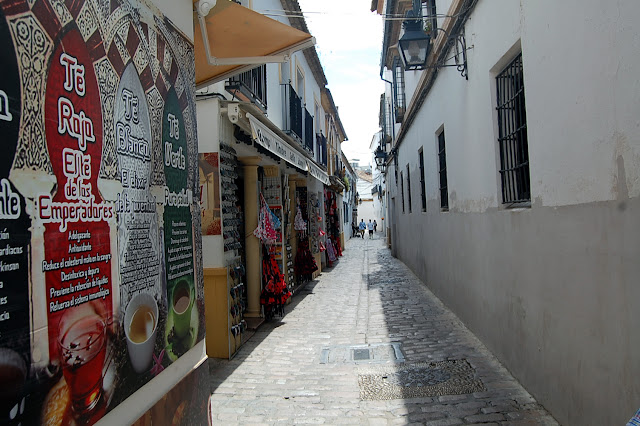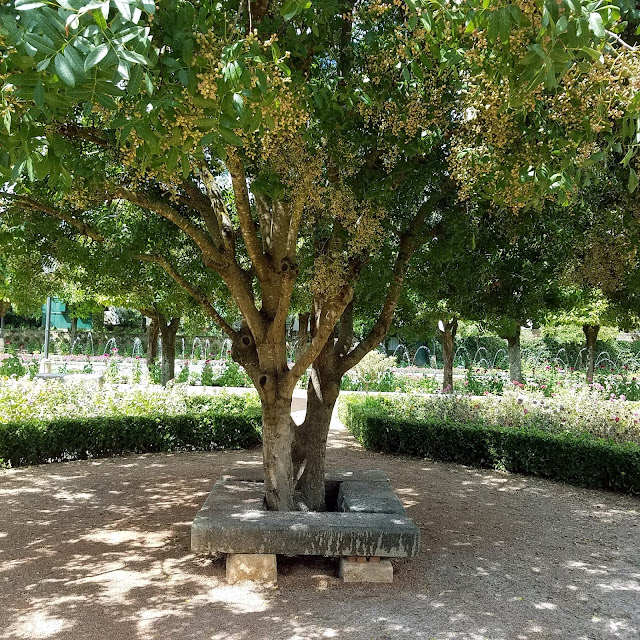We began this day with a drive to Cordoba. Along the way we passed millions of olive trees and several old Muslim forts occupying hilltops above small towns. Here is one such ancient fort with olive trees in the foreground.
Granada, our previous destination, means pomegranate in Spanish. At a rest area we saw this pomegranate tree.
The rest area also had posters advertising bull fights. Imposing, determined looking toreadors contemplated their horned opponents.
Upon arrival in Cordoba we were too early to check in to our hotel rooms. So we left our luggage in a protected lobby and headed out to get lunch. Just before entering the gate in the first picture below we walked past a statue of Seneca who was born in Cordoba. The city wall extended for some distance as you can see in the second image below.
Lunch was a variety of tapas in a small restaurant decorated with bull fighting memorabilia.
After lunch we walked through narrow streets towards the Alcazar de Los Reyes Cristianos passing a lovely entrance hall on the way.
The walls of the Alcazar de Los Reyes Cristianos were mighty. This fort was constructed in about 1328 by King Alfonso XI. It served as the royal residence when Christian kings stayed in Cordoba. In 1482 the Alcazar became headquarters for the Inquisition in Cordoba.
Just outside the Alcazar entrance gate a jovial artist captivated our group with small portraits done quickly with fingers on glass.
This imposing statue near the entrance is Alfonso X who first ordered the construction of the Alcazar which was later completed by Alfonso XI.
During its long history Cordoba was once a Roman city. It was conquered by Romans in 206 BCE. In 1959 a set of Roman floor mosaics were discovered under Cordoba's Corredera Square. They date from the 2nd and 3rd century AD and were once part of a Roman mansion. Now they are displayed on walls inside the Alcazar. Two examples are shown below.
Lovely gardens were associated with the Alcazar.
Statues of Ferdinand, Isabella, and Columbus were prominent in the garden.
 As we left the Alcazar we passed this fruit-laden date palm.
As we left the Alcazar we passed this fruit-laden date palm.Some approximation of religious tolerance existed for a time in Cordoba when three major religions lived together relatively peacefully during the 11th and 12th centuries. There was a significant Jewish presence in Cordoba, and this street, the Calle de Los Judios, was the location of a synagogue.
Embedded in the street were markers with Hebrew characters signifying Sephardic Jews.
The surviving synagogue was built in 1315. Its interior walls with Hebrew inscriptions are seen below.
Our next stop was the Mosque/Cathedral of Cordoba where we first encountered this imposing bell tower.
The entrance gate under the bell tower is the Puerta del Perdon where we saw the first example of blended Muslim and Christian symbols. The bell tower base was originally a minaret.
A beautiful ceiling attracted my attention overhead as we walked under the entrance arches.
A short walk through an interior courtyard, The Orange Tree Courtyard, brought us inside the Mosque/Cathedral itself. My initial reaction to the breathtaking interior was, "Whoa!" The immense forest of columns and colorful arches built in 785 seemed to extend to infinity. Many of the columns are recycled ancient Roman columns. Once again, single photos fail to capture the vast beauty in this building.
A fascinating blend of Muslim and Christian architecture was on display in several locations.
Once again, my head was spinning trying to see incredible sights in all directions. I left the local guide to wander around on my own.
As pointed out by the local guide, it was obvious how conquering Christians had purposely inserted a Christian cathedral right in the heart of the Muslim mosque.
After seeing the glorious Mosque/Cathedral we strolled back to the hotel wandering through streets of Cordoba. On the way we passed this attractive ceramic display.
I was happy to sit for a while in our hotel room, but energetic C went for a run in this park very near the hotel.
Tonight our late dinner consisted of oxtail, complete with intact tail bones! It was surprisingly tender and delicious. Tomorrow we head for our last stop, Madrid.














































No comments:
Post a Comment